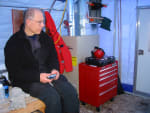The IceCube Collaboration presents the first search for neutrino sources using cascade events with an energy above 1 TeV. Although no significant clustering was observed, this method provides an independent technique to search for astrophysical neutrino sources. These results have just been submitted to The Astrophysical Journal. […]
News
Week 17 at the Pole
It surely is a staircase to the stars. That’s the ICL’s staircase, set against a backdrop of bright auroras low in the sky with a wide swath of the Milky Way above. Last week at the Pole was very much like the previous one—a well-behaved, quiet detector and an active night sky. […]
Week 16 at the Pole
Arms up—let’s hear it for auroras! With an extremely stable IceCube detector that needed little attention last week, IceCube winterover Martin was able to train his focus on the glorious skies. […]
Week 15 at the Pole
Last week’s photos from the Pole were full of blue and green. The first visible auroras were out, and they appeared as bright green swaths and swirls against a blue sky. A bright full moon and a tiny speck of Jupiter also made appearances. […]
Christian Spiering awarded the O’Ceallaigh Medal
The Commission on Astroparticle Physics of the International Union of Pure and Applied Physics (IUPAP) has awarded the 2017 O’Ceallaigh Medal to Christian Spiering, an IceCube collaborator and a researcher at DESY-Zeuthen, for his “outstanding contributions to cosmic ray physics and to the newly emerging field of neutrino astronomy in particular.” Spiering will receive the award during the International Cosmic Ray Conference (ICRC), in July 2017, in Busan, South Korea. […]
Aya Ishihara wins Saruhashi Prize
Aya Ishihara, an IceCube collaborator and an associate professor of physics at Chiba University in Japan, has been awarded the 37th annual Saruhashi Prize, given each year to a female researcher in the natural sciences. This award recognizes women scientists under 50 for exceptional research accomplishments and for mentoring of other women scientists. […]
Week 14 at the Pole
Another amazing week at the Pole—not only was the detector performing well but the twilight photographs continued to be stunning. IceCube winterover Martin captured another great time-lapse shot of a NOAA weather balloon launch along with some striking images of the station and the IceCube Lab. […]
Len Shulman (1950-2017)
Subir Sarkar recognized with the Homi Bhabha Award
The International Union of Pure and Applied Physics (IUPAP) and the Tata Institute of Fundamental Research (TIFR) in Mumbai, India have given the 2017 Homi Bhabha Award to Subir Sarkar, an IceCube collaborator and a professor of physics at both the universities of Oxford and Copenhagen, for his “distinguished contributions in the field of high energy cosmic ray physics and astro-particle physics over an extended academic career.” Prof. Sarkar will receive the award certificate and medal during the inauguration session of the International Cosmic Ray Conference, on July 20, 2017, in Busan, South Korea. […]
Week 13 at the Pole
The sun has set, they’ve held their traditional sunset dinner, and yet … it’s still light outside. Well, that’s twilight. Even after the sun falls below the horizon, the scattering of light in the upper atmosphere illuminates the lower atmosphere and the Earth’s surface. […]









